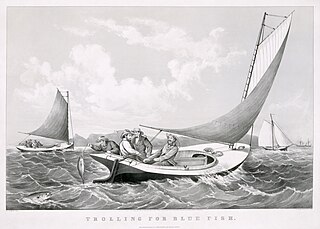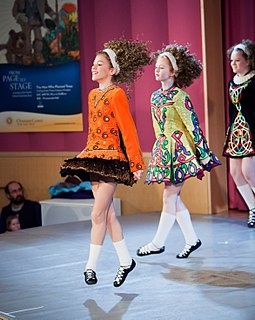| Look up jig in Wiktionary, the free dictionary. |
A jig is a type of folk dance.
Contents
Jig may also refer to:
| Look up jig in Wiktionary, the free dictionary. |
A jig is a type of folk dance.
Jig may also refer to:
| This disambiguation page lists articles associated with the title Jig. If an internal link led you here, you may wish to change the link to point directly to the intended article. |

Contra dance is a folk dance made up of long lines of couples. It has mixed origins from English country dance, Scottish country dance, and French dance styles in the 17th century. Sometimes described as New England folk dance or Appalachian folk dance, contra dances can be found around the world, but are most common in the United States, Canada, and other Anglophone countries.

The jig is a form of lively folk dance in compound metre, as well as the accompanying dance tune. It developed in 16th-century England, and was quickly adopted on mainland Europe where it eventually became the final movement of the mature Baroque dance suite. Today it is most associated with Irish dance music, Scottish country dance and the Métis people in Canada. Jigs were originally in duple compound metre,, but have been adapted to a variety of time signatures, by which they are often classified into groups, including light jigs, slip jigs, single jigs, double jigs, and treble jigs.

Trolling is a method of fishing where one or more fishing lines, baited with lures or bait fish, are drawn through the water. This may be behind a moving boat, or by slowly winding the line in when fishing from a static position, or even sweeping the line from side-to-side, e.g. when fishing from a jetty. Trolling is used to catch pelagic fish such as salmon, mackerel and kingfish.

The smallmouth bass is a species of freshwater fish in the sunfish family (Centrarchidae) of the order Perciformes. It is the type species of its genus. One of the black basses, it is a popular game fish sought by anglers throughout the temperate zones of North America, and has been spread by stocking—as well as illegal introductions—to many cool-water tributaries and lakes in Canada and more so introduced in the United States. The maximum recorded size is approximately 27 inches and 12 pounds. The smallmouth bass is native to the upper and middle Mississippi River basin, the Saint Lawrence River–Great Lakes system, and up into the Hudson Bay basin. Its common names include smallmouth, bronzeback, brown bass, brownie, smallie, bronze bass, and bareback bass.
The following is an overview of the events of 1896 in film, including a list of films released and notable births.

Crappies are a genus, Pomoxis, of North American fresh water fish in the sunfish family Centrarchidae. Both species in this genus are popular pan fish.

Ice fishing is the practice of catching fish with lines and fish hooks or spears through an opening in the ice on a frozen body of water. Ice fishers may fish in the open or in heated enclosures, some with bunks and amenities.

Jigging is the practice of fishing with a jig, a type of fishing lure. A jig consists of a lead sinker with a hook molded into it and usually covered by a soft body to attract fish. Jigs are intended to create a jerky, vertical motion, as opposed to spinnerbaits which move through the water horizontally. The jig is very versatile and can be used in both salt and fresh water. Many species are attracted to the lure which has made it popular among anglers for years.

A fishing lure is a type of artificial fishing bait which is designed to attract a fish's attention. The lure uses movement, vibration, flash and color to bait fish. Many lures are equipped with one or more hooks that are used to catch fish when they strike the lure. Some lures are placed to attract fish so a spear can be impaled into the fish or so the fish can be captured by hand. Most lures are attached to the end of a fishing line and have various styles of hooks attached to the body and are designed to elicit a strike resulting in a hookset. Many lures are commercially made but some are hand made such as fishing flies. Hand tying fly lures to match the hatch is considered a challenge by many amateur entomologists.

Handline fishing, or handlining, is a fishing technique where a single fishing line is held in the hands. It is not to be confused with handfishing. One or more fishing lures or baited hooks are attached to the line. A hook, fishing lure, or a fishing jig and many times a weight and/or a fishing float can be attached to the line. Handlining is among the oldest forms of fishing and is commonly practiced throughout the world today.
A shoe is a piece of outerwear worn on one's foot.

A bush band is a group of musicians that play Australian bush ballads. A similar bush band tradition is also found in New Zealand.

The Provincetown Players was a collective of artists, writers, intellectuals, and amateur theater enthusiasts. Under the leadership of the husband and wife team of George Cram “Jig” Cook and Susan Glaspell from Iowa, the Players produced two seasons in Provincetown, Massachusetts and six seasons in New York City, between 1916 and 1923. The company's founding has been called "the most important innovative moment in American theatre." Its productions helped launch the careers of Eugene O'Neill and Susan Glaspell, and ushered American theatre into the Modern era.
A Feis or Fèis is a traditional Gaelic arts and culture festival. The plural forms are feiseanna and fèisean. The term "feis" is commonly used referring to Irish dance competitions and, in Scotland, to immersive teaching courses, specialising in traditional music and culture. In Scottish Gaelic, the accent is important because there is a difference of meaning and pronunciation between 'feis' and 'fèis' - the word 'feis' means sexual intercourse,.
African-American dance has developed within Black American communities in everyday spaces, rather than in studios, schools or companies. These dances are usually centered on folk and social dance practice, though performance dance often supplies complementary aspects to this. Placing great value on improvisation, these dances are characterized by ongoing change and development. There are a number of notable African-American modern dance companies using African-American cultural dance as an inspiration, among these are the Whitey's Lindy Hoppers, Alvin Ailey American Dance Theater, Dance Theatre of Harlem, and Lula Washington Dance Theatre. Unlike European-American dance, African-American dance was not taxed in the fields of Europe where it began and has not been presented in theatrical productions by generations of kings, tzars, and states. Instead, it lost its best dancers to the draft and started requiring taxes from establishments in the form of a federal excise tax on dance halls enacted in 1944. Dance halls continue to be taxed throughout the country while dance studios are not, and African-American dance companies statistically receive less taxpayer money than European Americans. However, Hollywood and Broadway have provided opportunities for African-American artists to share their work and for the public to support them. Michael Jackson and Beyoncé are among the most well-known African-American dancers.

Irish stepdance is a style of performance dance with its roots in traditional Irish dance. It is generally characterized by a stiff upper body and quick and precise movements of the feet. It can be performed solo or in groups. Aside from public dance performances, there are also stepdance competitions all over the world. These competitions are often called Feiseanna. In Irish dance culture, a Feis is a traditional Gaelic arts and culture festival. Costumes are considered important for stage presence in competition and performance Irish stepdance. In many cases, costumes are sold at high prices and can even be custom made. Males and females can both perform Irish stepdance but for the most part in today's society, the dance remains predominantly female. This means that the costumes are mainly dresses. Each dress is different, with varying colors and patterns, designed to attract the judge's eye in competitions and the audience's eye in performance. General appearance besides the costume is also equally important. Dancers would typically curl their hair before each competition. Many dancers invest in curled wigs that match their hair color. Poodle Socks are worn with the dresses and shoes. These are white socks that stretch to mid calf with distinctive ribbing.

Kayak fishing is fishing from a kayak. The kayak has long been a means of transportation and a means of accessing fishing grounds. Kayak fishing has gained popularity in recent times.

Fishing techniques are methods for catching fish. The term may also be applied to methods for catching other aquatic animals such as molluscs and edible marine invertebrates.
The following outline is provided as an overview of and topical guide to fishing:

The 2010 Bonnaroo Music and Arts Festival was held on June 10–13, 2010. The line-up was announced Tuesday, February 9, although the original line-up release date was scheduled for February 2. It was broadcast live on YouTube. Pre-sale tickets went on sale November 27, 2009.